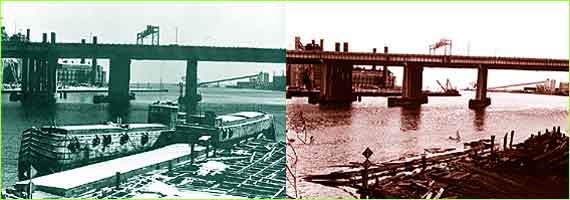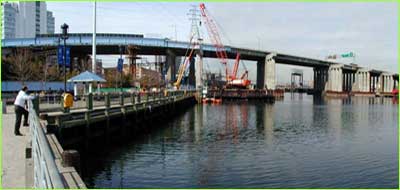


The sinking of the Berkshire No. 7, 1974
One spring day in 1974, at a deteriorating pier in Bridgeport Harbor, a barge took on water and slowly sank to the bottom dragging down two others that were moored to it. Over twenty-five years later, with the old pier demolished and rebuilt, they still sit atop one another. At low tide, the gunwale (upper edge of the ship's side) of one barge can be seen from the Stratford Avenue Bridge.
The Berkshire No. 7 was built in 1935 and is 104 feet long. It is the latest of the three barges and represents the transition between the small wooden barges of the 19th century and today's large steel barges. The second barge is the 111 foot long Priscilla Dailey. She was built in 1929 and is one of the few surviving wooden canal boats that represent a style virtually lost over the decades. Of the three barges, the most historically significant is probably the Elmer S. Dailey. It was built in 1915 and is 105 feet long. As with the other two barges, its most recent voyages involved the transportation of bulk material between New York, New Jersey, and Connecticut. However, it is believed to be the last remaining Erie Canal boat in the country.

The site of the submerged barges in 1999.
Because of proposed redevelopment in Bridgeport Harbor, the State Police diving team inspected the vessels in 1997. They reported that much deterioration had occurred. It remains for a professional marine archaeologist to help authorities determine the potential for raising and preserving one or more of the barges, leaving them alone (in situ), or, if significantly deteriorated, destroying them. These are the only shipwrecks in Connecticut listed on the National Register of Historic Places.